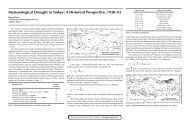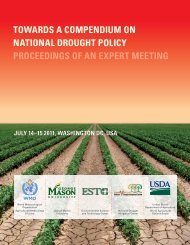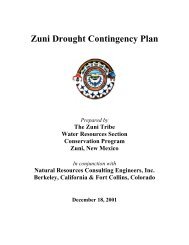Table of Contents - National Drought Mitigation Center - The ...
Table of Contents - National Drought Mitigation Center - The ...
Table of Contents - National Drought Mitigation Center - The ...
Create successful ePaper yourself
Turn your PDF publications into a flip-book with our unique Google optimized e-Paper software.
Box 2: <strong>The</strong> U.S. <strong>Drought</strong> Monitor and the<br />
Seasonal <strong>Drought</strong> Outlook<br />
<strong>The</strong> U.S. <strong>Drought</strong> Monitor is hosted by the <strong>National</strong> <strong>Drought</strong> <strong>Mitigation</strong> <strong>Center</strong> in Lincoln, Nebraska. <strong>The</strong> primary entry page<br />
is http://www.drought.unl.edu/dm/. <strong>The</strong> major system components consist <strong>of</strong> 1) the <strong>Drought</strong> Monitor, 2) a description <strong>of</strong> the<br />
participants, 3) forecasts, ) current conditions, 5) product archive, 6) what’s new, and 7) who to contact. <strong>The</strong> components<br />
contain links to products that are contained on partner agency web pages.<br />
<strong>The</strong> creation <strong>of</strong> the U.S. <strong>Drought</strong> Monitor was a pivotal event for agencies and states. Prior to 1999, most drought decisionmaking<br />
was based on the Palmer <strong>Drought</strong> Severity Index. <strong>The</strong> USDM was created to better integrate data on current<br />
conditions in a standard product providing a national overview <strong>of</strong> drought on a continuous, weekly basis. It provided a<br />
forum for discussion among drought monitoring experts around the country, leading to a widely-acknowledged improved<br />
product for decision-making, and providing a catalyst for informing drought monitoring product development. <strong>Drought</strong><br />
fora, organized around the USDM, have been held regularly and are now scheduled every two years. <strong>The</strong> USDM subsequently<br />
inspired the North American <strong>Drought</strong> Monitor, involving collaboration among Canadian, Mexican, and United States’<br />
scientists.<br />
In 2000, the U.S. Seasonal <strong>Drought</strong> Outlook was created to more systematically present drought forecasts available from<br />
the atmospheric science community. In 2005, the U.S. Water Monitor website (http://watermonitor.gov) was brought on line<br />
to provide convenient access to stream flow, reservoir, ground water, and snow observational data and forecasts. Also in<br />
2005, the <strong>Drought</strong> Impact Reporter was launched as an effort to capture the entire impact side <strong>of</strong> the monitoring equation.<br />
<strong>The</strong>se information sources are invaluable steps, but by themselves fall short <strong>of</strong> full integration <strong>of</strong> available data to improve<br />
monitoring, providing a better understanding <strong>of</strong> how and why droughts occur, enhancing dissemination <strong>of</strong> information at the<br />
required spatial and temporal scales, and enhancing the forecasting <strong>of</strong> droughts.<br />
help them with decisionmaking. <strong>The</strong>se<br />
products need to be designed for the various<br />
stakeholders at the appropriate scales required<br />
by the stakeholders. It would be especially<br />
effective if the option existed for stakeholders<br />
to test a variety <strong>of</strong> scenarios to assist and guide<br />
their decision-making processes.<br />
One goal <strong>of</strong> NIDIS is to build upon already existing<br />
competencies, experience in other hazards management,<br />
and technologies developed among agencies from the local<br />
to international level. <strong>The</strong> U.S. <strong>Drought</strong> Monitor (USDM;<br />
Box 2), an example <strong>of</strong> which is shown in Figure 2, is a widelyregarded<br />
composite drought hazard assessment tool. It is<br />
the result <strong>of</strong> an innovative effort by the U.S. Department<br />
<strong>of</strong> Agriculture (USDA), NOAA, and the <strong>National</strong> <strong>Drought</strong><br />
<strong>Mitigation</strong> <strong>Center</strong> (NDMC) to consolidate and synthesize<br />
a wide variety <strong>of</strong> data and information available from state<br />
partners into a single map that summarizes the current<br />
status <strong>of</strong> drought in the United States. This “static” map is<br />
not intended to represent the complexity <strong>of</strong> drought impacts<br />
which requires consideration <strong>of</strong> the joint occurrence <strong>of</strong><br />
drought and vulnerability. <strong>The</strong>re is agreement that a more<br />
robust suite <strong>of</strong> products is needed, as well as improved<br />
navigation tools that focus on specific stakeholder needs and<br />
cross-scale (federal, state, local) collaboration.<br />
appendix a-1 describes four additional examples <strong>of</strong><br />
collaborative products and processes that will provide<br />
bases for progressing with NIDIS early warning system<br />
development. An additional example includes the<br />
Community Collaborative Rain, Hail, and Snow Network<br />
(CoCoRaHS), which was expanded during the 2002 drought<br />
to include local drought monitoring and increase public<br />
awareness (see http://www.cocorahs.org).<br />
<strong>The</strong> NIDIS Implementation Plan as laid out in the following<br />
pages provides a roadmap for improving the current system<br />
described above to meet the critical needs identified in the<br />
WGA Report (2004) and the NIDIS Act <strong>of</strong> 2006 (Public<br />
Law 109-430).<br />
3. the nIdIS ImplementatIon Strategy<br />
<strong>The</strong> implementation strategy is intended to effect the design,<br />
conduct and maintenance <strong>of</strong> a national integrated drought<br />
early warning information system that:<br />
• Draws upon multiple warning sources<br />
(federal, state, local) and partnerships<br />
for data gathering;<br />
• Enables state and county level managers<br />
to provide more effective public warnings<br />
based on drought risk indicators and<br />
triggers for particular decisions;<br />
• Ensures that only authorized <strong>of</strong>ficials may<br />
enter alerts and warnings;<br />
• Is based on an open, non-proprietary<br />
architecture;<br />
• Employs uniform alert and warning<br />
terminology that is clearly understood by<br />
recipients; and








